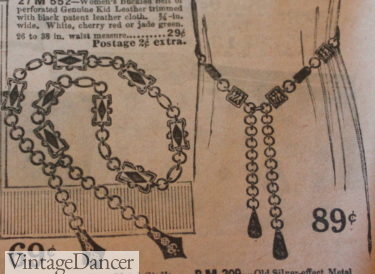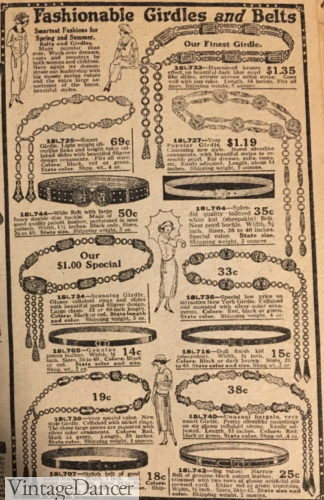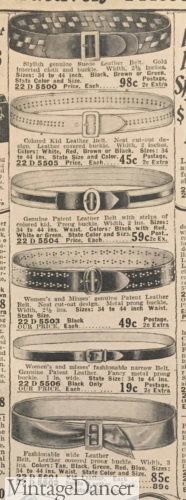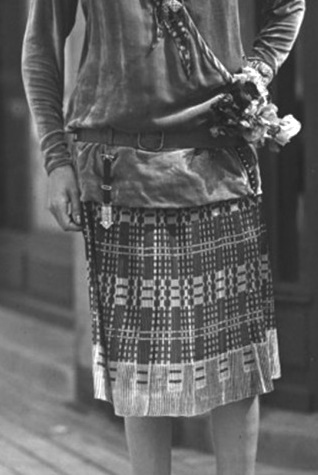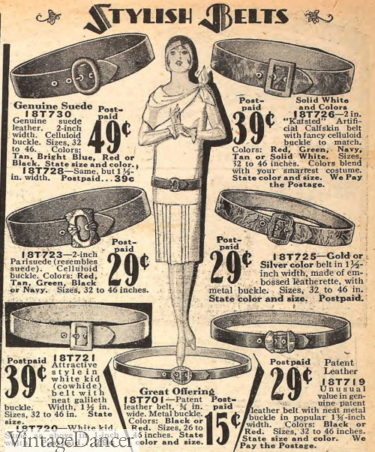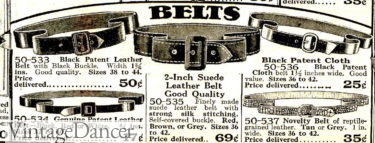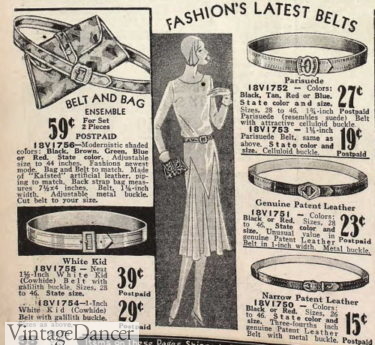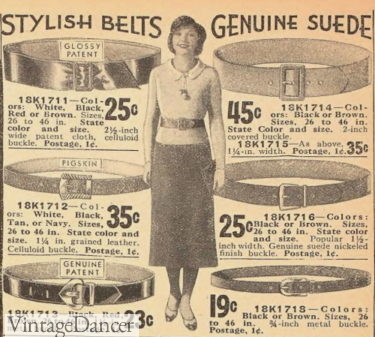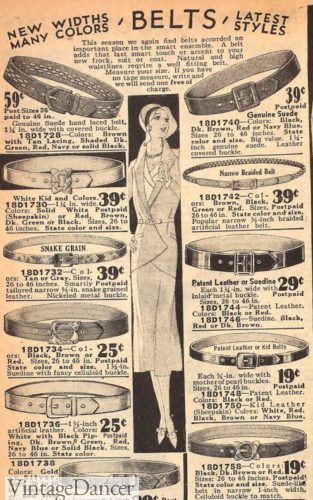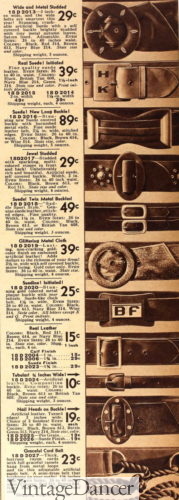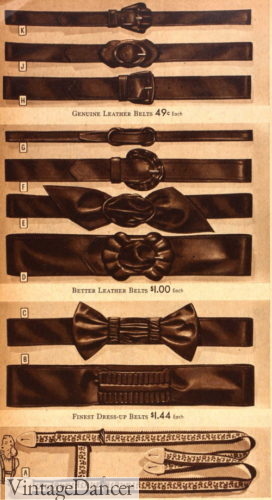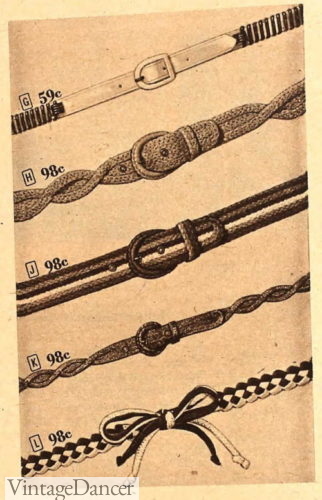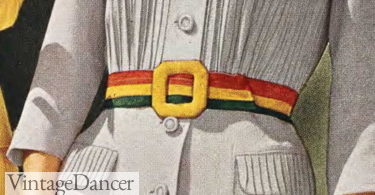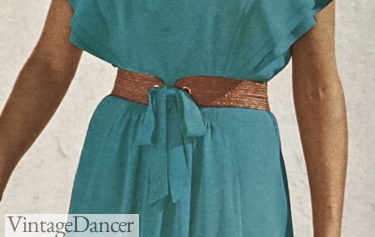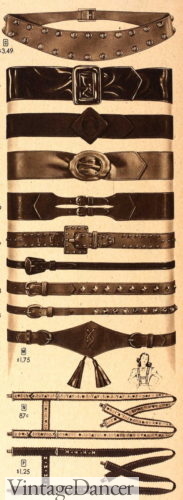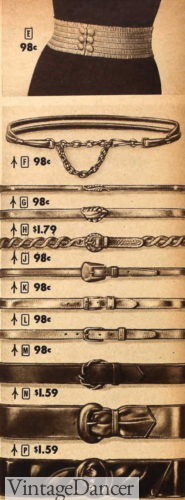This article will explore a history of women’s belts from 1920-1960. Here, I will showcase popular styles, materials, and the way in which belts were generally worn and included as a fashion accessory.
Shop 1950s skinny or wide style cinch belts.
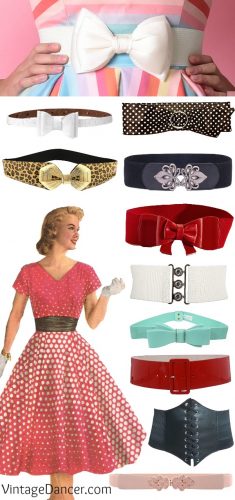
Vintage belts: wide belts, cinch belts, skinny belts, bow belts, pinup belts
A History of Belts 1920-1960
While belts can be an integral element to an outfit, on the whole their history has remained unexplored. Entire books exist exploring the design history of various accessories — particularly handbags, shoes, and costume jewelry — whereas belts seem to have escaped this scrutiny. Perhaps this omission is due in part to the categorization of this item. Although belts seem to be classed as a fashion accessory, they may also in some cases, due to their decorative nature, be considered costume jewelry.
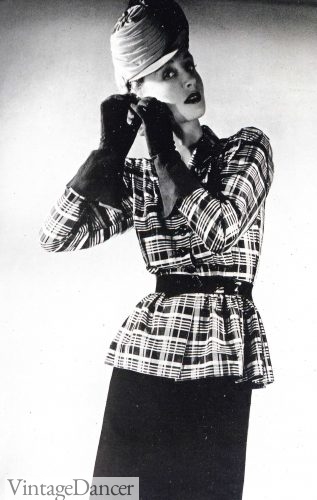
Belts started to feature as prominent fashion accessories from the 1930s onwards. This example is from Harper’s Bazaar, 1948.
Centuries ago, belts were used for their practical nature. Purses and fans would hang from belts, and during conflicts they may have been used to carry weaponry. Of course, belts would also serve the important purpose of keeping an outfit in place — whether that be by holding a waistband securely to the body, or by keeping robes together.
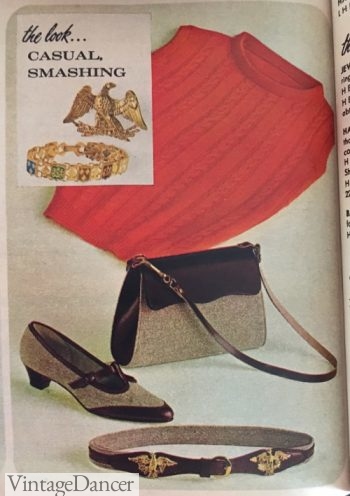
1964 coordinated accessories with a metal trim belt
Belt Styles of the 1920s
During the 1920s, belts were usually made from the same material as the dress they were intended to be worn with. As the waistline dropped to the hips, women wore loose belts on the new low waistline.
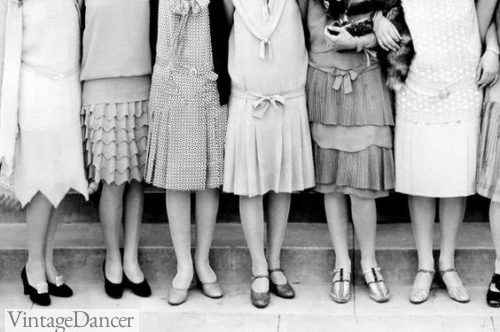
A selection of self fabric belts and sashes from the mid 1920s.
Belts could be fashioned from fabric, ribbon, cloth, suede, patent leather, metal or were decorated with elaborate beading. Buckles were small and could be made from various materials, including early plastics, glass, and paste. Most belts were skinny- 3/8 inches or a bit wider at 1 1/2 inches.
The chain medallion belt fad around 1992-194 had ladies wearing loose metal belts over long slip dresses.
- 1922 chain medallion belts
- 1923 chain metal medallion belts
In the autumn of 1926, Good Housekeeping declared: ‘Belts are as important on morning and sports models as girdles and sashes are on afternoon ones.’
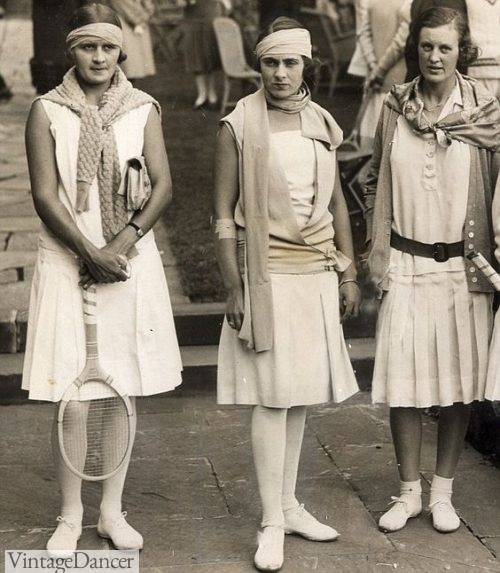
Often during the early years of the 1920s, belts were worn with sporting attire.
In the 1920s, belts were normally reserved for more casual occasions or styles of dress, such as sportswear and morning attire. When the two piece skirt and tunic blouse set became fashionable, a leather belt or skinny patent leather belt was the perfect accessory circling the mid hip.
This casual look spread to afternoon dresses, sporty tennis dresses and even swimwear.
- 1925 sport belts of mixed leather or fabric
- Leather belt with skirt and tunic blouse
- 1929 women’s belts
- 1929 leather and patent belts
Alternatively, for occasions requiring more formality, sashes were often utilized in place of a belt. However, towards the end of the decade, belts started to be included in evening ensembles and more formal modes of dress.
See ideas of how to wear a sash or belt in the 1920s.
Belt Styles of the 1930s
In the 1930s, belts were included with almost every dress- day or night. The belt accented the new waistline that sat just above the naval. “Belt effects” such as darts, gores, button tabs and surplices sewn into dresses and coats also created the nipped waist, making a perfect canvas for the hang.
During the early 1930s, belt widths were slim. They were often made of the same fabric as the dress but could also be contrasting in bright red, blue or white for sporty outfits. Shiny patent leather with silver buckles was still popular in the early years.
Suede leather was to become *the* best material for belts in the 1930s. Soft and pliable they were gentle to wear around the belly.
- 1930
- 1932
- 1930
- 1934
Textured belts such as braided leather, nailhead, reptile skin, sculpted metal, cords, raffia and woven yarn added dimension over a plain colored dress.
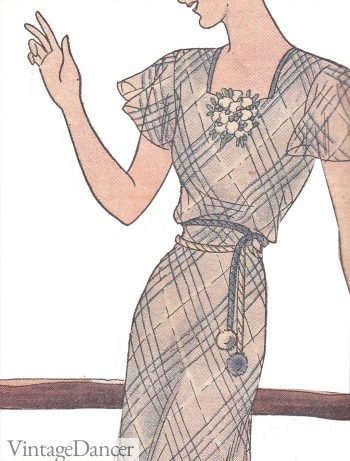
During the 1930s, belts may feature feminine design details such as the pom-pom trim on this belt from 1937.
Wider belts in the corset shape, pull through, and long sashes were at least 3 to 5 inches wide. The were seen throughout the 1930s but especially in the last few years.
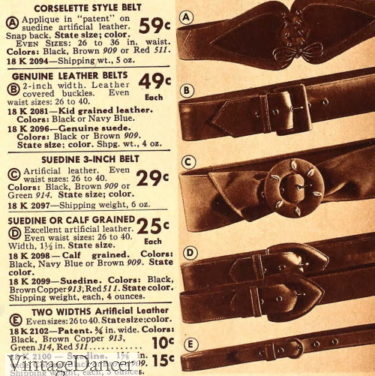
1938 wide belts
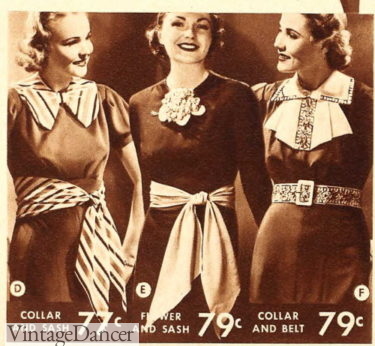
1938 sash belts and wide tooled leather belt
The key component of the simple belt was the buckle, which was frequently used as a decorative feature. Buckles came in many shapes and sizes, from diamond shapes to two-part rectangular clasps. The round circle buckle was also incredibly popular.
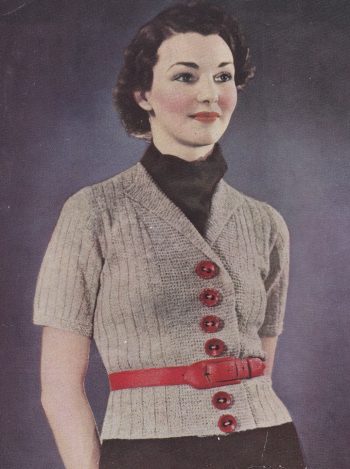
Belt styles of the 1930s began to become more utilitarian towards the end of the decade. This example is from Stitchcraft magazine, 1937.
Buckles were made of metal but more so colorful plastics. They were cheaper and prettier, more feminine, than a heavy metal buckle. Covering buckles in fabric was another way to hide metal.
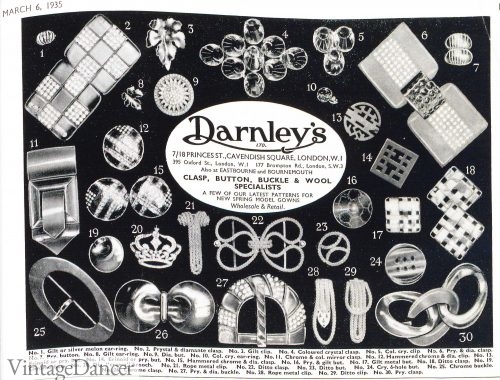
A selection of buckles and clips as advertised in British Vogue, March 1935.
One belt trend in the late 1930s include those with sculpted flowers and leaves. Buckles were made from Tenite, a plastic, that could be molded into floral shapes. Cut leather could be placed 3D on bels.
The buckle, like purses and other, was another spot to place the wearer’s initials. It required a heavy to wide belt buckle to accommodate the one to 3 letter placements.
- 1936 with initials
- 1936 with texture
- 1938- with florals and leaf designs
Designers embraced the show stopping appeal of the buckle, creating unusual shapes and styles. Indeed, Diana Vreeland wrote in her ‘Why Don’t You..’ page for Harper’s Bazaar – “Why don’t you.. order Schiaparelli’s cellophane belt with your name and telephone number written on it?.”
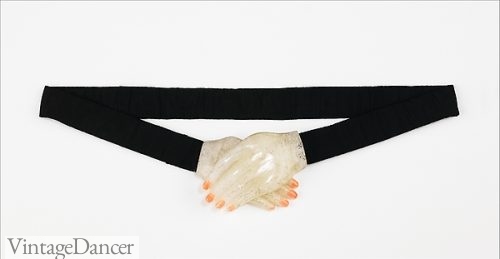
This 1934 evening belt by Schiaparelli demonstrates the increasing importance of the belt buckle. Image via The Met Museum – click to view the original entry.
For evening wear, belts became more elaborate as befitting the occasion. Buckles were highly decorative, made from early plastics, glass, brass, silver, and paste. Popular shapes of buckle include geometric shapes such as squares, diamonds, and rectangles decorated in real or fake sparkles. Belt fastenings were not limited to the center front — belts were also seen buckled at the back of evening and afternoon gowns.
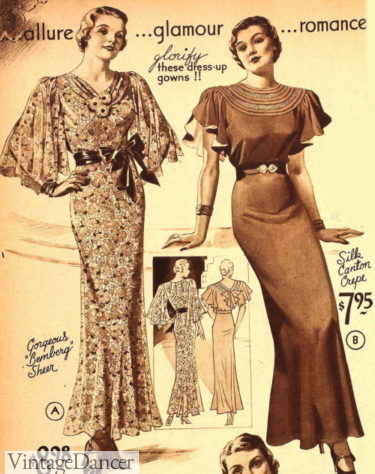
1934 evening dress belts
Belt Styles of the 1940s
By the 1940s, belts became more utilitarian in style. L-85 restrictions reduced the width to only 2 inches. While day dresses often featured matching fabric belts, increasingly tougher materials such as leather and suede were employed. Due to leather shortages due to WWII, alternative materials were sought to create a similar effect.
- 1944 leather belts
- 1948 straw, plastic, braided faux leather belts
Wide petersham ribbon was a durable substitute. Belts were also made from tough canvas material, covered either with decorative fabric or crocheted/knitted designs. In summer they could be woven from straw or molded plastic.
- 1946 ribbon belt
- 1947 straw belt with tie sash
The wide belt was nothing new in the 1940s but the designs continued to expand. The corselette style belt with one to three mini buckles across the front was very trendy. So was the lace front belt that looked like a corset back. The shirred belt would later become the Cinch belt in the 1950s was introduced in the early 1940s.

1940 shirred belt (cinch style), lace front and bow tied wide belts

1946 wide belts
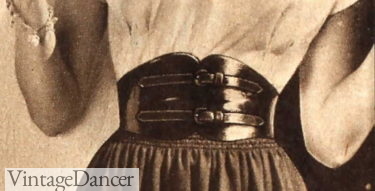
1946 corselet belt
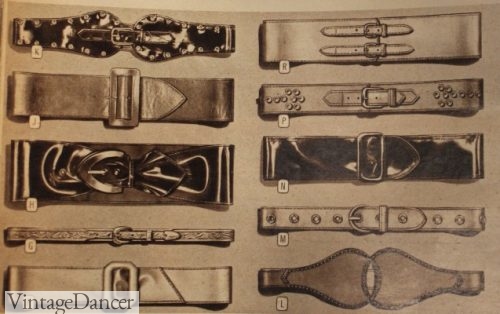
1947, wide Belts for Dior’s New Look
By the end of the decade, although belts were worn on the natural waistline, their function was not wholly to nip in the waist. By creating a slender waistline in contrast, the hips may have appeared rounder – a silhouette that Dior championed through his New Look of 1947.
The skinny belt had its place in the 1940s wardrobe as well. It paired beautifully over dresses and suits or around skirt waistbands.
- 1946 wide and skinny belts
- 1948 skinny and wide belts
- 1949 skinny belts
The other unique style of belt was called a ladies suspenders, modeled after lederhosen outfits. They were paired with dirndl skirts and sometimes pants. Red felt, brown leather, gold studded straps were decorated with embordered flowers on white tape. Teens wore them more often than women.

1944 suspenders
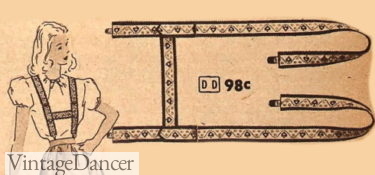
1948 suspenders
1950s Belt Styles
Belt styles of the 1950s were wider than previous decades. At first they were only 2 inches wide, but they grew into massive 5 inch wide bands by the middle of the decade. Wide belts were also worn in the late ’40s, creating a wide-thin-wide roller coaster throughout the decade.
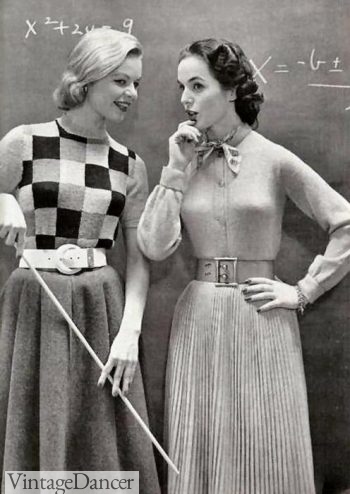
Wide belts divide tops and skirts
The function of the 1950s belt was to nip-in the silhouette like a corset, in order to enhance the hips. Belts were worn with practically any outfit – day dresses, suits, pants, over long sweaters… Even outwear echoed the nipped-in waist line of fashion.
Colors could match the outfit, but often contrasted in white, black, or another bright color or pattern in order to draw attention to the small waist. If a woman did not have a small waist, she was advised against wearing belts (although this rule is ignored today and for good reason — belts are a wonderful figure enhancing accessory).
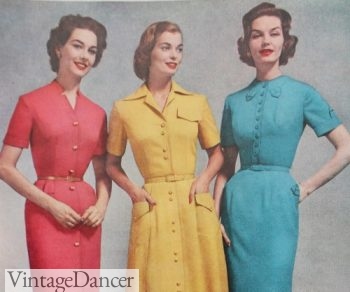
1957 skinny belts were in style
While fashion designers had realized the potential of creating matching accessories to compliment their designs, the price commanded was often too high for the masses. However, Claire McCardell worked to bring affordable designs to the fashion conscious consumer. McCardell focused on practicality, comfort, and function.
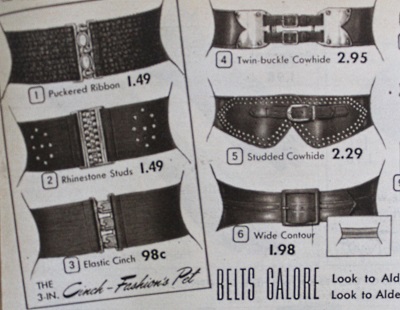
1953 Ribbon, Elastic and Leather belts
One of her key accessory designs was a wide belt made from sturdy-yet-stretchy elastic. They were given the name cinch belts and were made of wide elastic or fabric that either laced or clasped in the front. The cinch belt has remained the most iconic belt style of the 1950s. Although their use was not heavily pictured in the media, they were sold from the early years to the end of the decade.
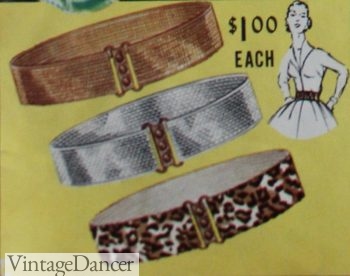
1958 classic cinch belts- most repro belts are in this simple design
Most dresses were sold with matching or complementary color belts with squared buckles made of self-fabric. They could be made of stiff fabric, leather, or shiny plastics. The size of the buckle matched that of the dress details. Simple dresses and suits had thin belts while fancier or trimmed dresses had slightly bigger belts. In the mid 50s the squared belt buckle was rounded out around corners for a more feminine look.

1957 skinny belts
House dresses and informal summer dresses had the most comfortable belt, which was a matching strip of fabric tied around to the front in a bow. It was the least restrictive and most flexible of the belt style and remained common throughout the decade. Some party dresses as had this style of a belt, but the fabric was more rope like and simply ornamental, not waist cinching.
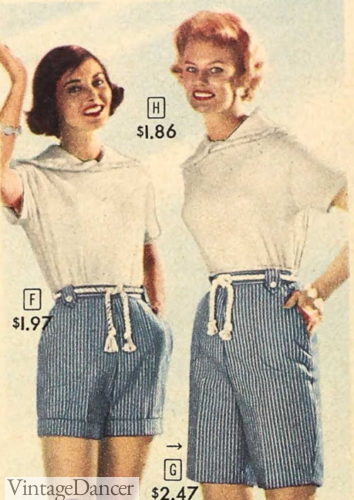
1959 rope belts for summer casuals
Year by Year Fashion Trends.
In 1952 the cummerbund belt was in fashion. It was another style women could make at home by pleating horizontally a few rows, stitching into a Petersham ribbon, and securing around the waist with 2 or 3 buttons (at the back). It stayed on trend for the entire decade.
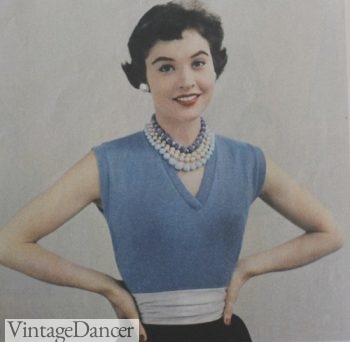
1954 white cummerbund belt
In 1953, adding some dazzle to belts was the in fashion style. Beads, gems, and rhinestones studded belt buckles and bands equally.
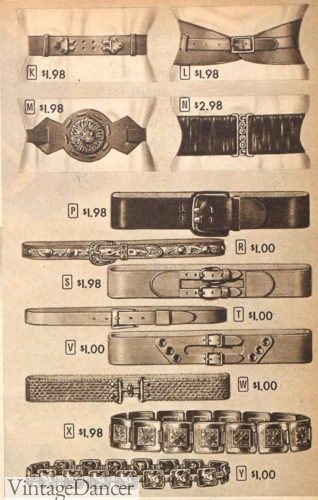
1952 belts- leather or metal
In 1954, the sash became a simple alternative to a classic belt. It was a simple 6 inch strip of fabric with finished edges. At its widest, it took on the shape of a Japanese obi belt.

In 1957, the concha belt or metal medallion belt was briefly in fashion. The trend began a few years earlier but was slow to be adopted. It would return in the late 1960s, when the earthy bohemian and disco looks took center stage.
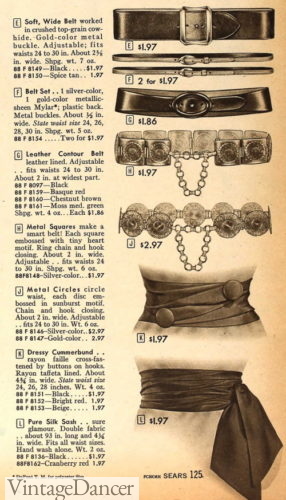
1959 metal squares chain belts, cummerbund, and silk sash
Also around 1957, the skinny belt was outpacing sales of wide belts. It was only an inch or so wide with small metal buckle. It looked especially charming around sheath dresses, pencil skirts, and ladies’ suits. It also looked nice with high waisted capris and cigarette pants that now had belt loops stitched into the band.
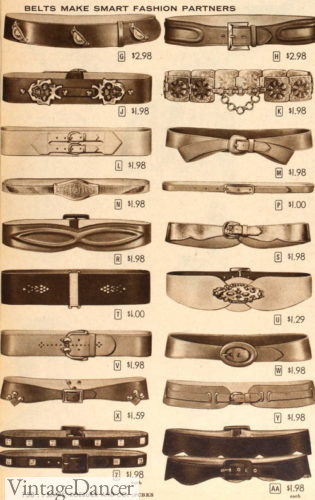
1956 belts
The look was more masculine with the addition of the belt loops, but the skinny belt kept it ladylike as well. Swing dresses continued to be sold with narrow or wide belts and a cummerbund style, but there was an increasing trend not to wear belts with these fuller styles.
In 1958, the sash belt returned with a single or double tail hanging down the front side. It could be self tied, pinned with a brooch or strung through a metal ring.
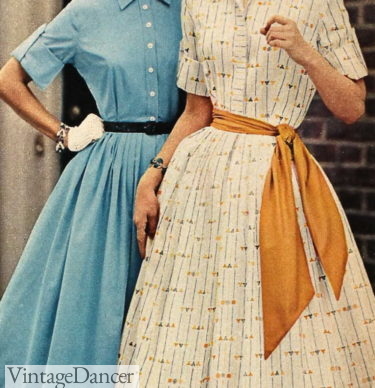
1958 skinny and sash belts
The last year, 1959, saw all belt widths worn again, from skinny to wide. Newer styles had a more modern futuristic look with wide, belt buckles, and grommeted holes. Belt color usually matched perfectly so as not to stand out. Belts with flat bows for buckles continued into the early 60s, when every dress was trimmed with a bow at the waist.
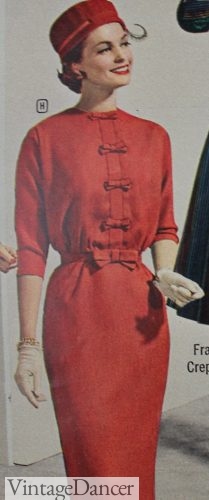
1959 bow belt
1960s Belt Styles
In the 1960s, we see the waistline position alter. During the early years of the decade, the fashionable waistline was worn on the natural waist. However, as the decade progressed, the waistline dropped to the hips almost in a recreation of 1920s styles.
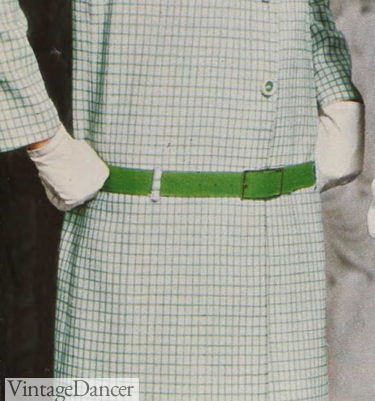
1967 drop waist with a green suede belt
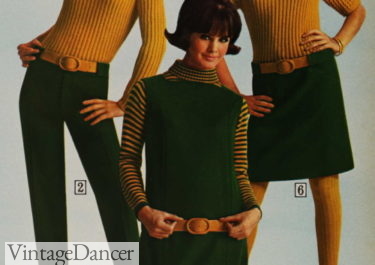
1966 hip hugger belts
Towards the end of the decade, belts fashioned from various metals were popular. Belts may closely resemble costume jewelry during this decade, with gilt chains of interlocking loops worn low on the hips. These were called Bikini chain belts and were usually worn over a bikini swimsuit or hip hugger pants in the late 1960s.
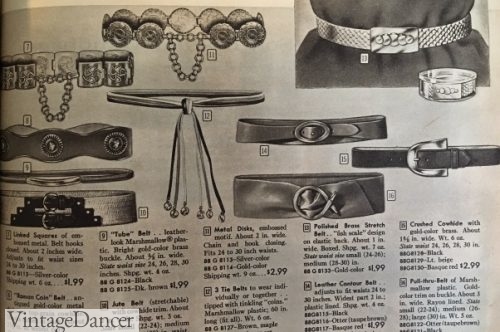
1961 Belt styles were quite diverse
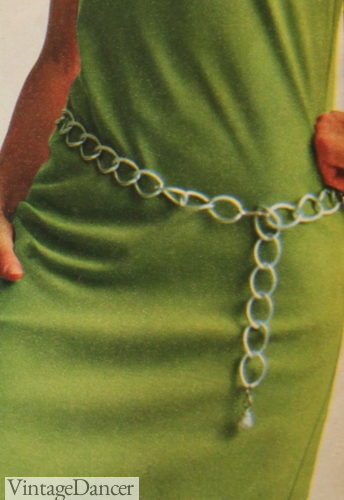
1968 chain metal belt
Leather and suede materials were still popular, with buckles often in large rectangular styles. The Gaucho belt of the late 1960s and 1970s was made of medallions of leather and metal joined with a chain. It had a southwest or Spanish flair to the design.
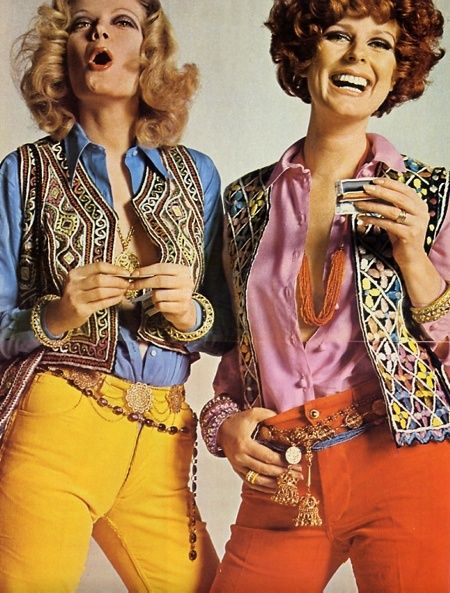
1960s boho/hippie belts
Shop Vintage Style Belts
Debbie Sessions has been teaching fashion history and helping people dress for vintage themed events since 2009. She has turned a hobby into VintageDancer.com with hundreds of well researched articles and hand picked links to vintage inspired clothing online. She aims to make dressing accurately (or not) an affordable option for all. Oh, and she dances too.
